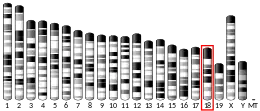HBEGF
فاکتور رشد شبه EGF متصلشونده به هپارین (انگلیسی: Heparin-binding EGF-like growth factor) که گاهی بهصورت «HB-EGF» هم نوشته میشود، یکی از پروتئینهای متعلق به خانوادهٔ فاکتور رشد اپیدرمی است که در انسان توسط ژن «HBEGF» کُد میشود.
این مولکول توسط ماکروفاژها و مونوسیتها، بهصورت یک گلیکوپروتئین میتوژنیک و کموتاکتیک متصلبه غشاء ساخته میشود و تمایل اتصالی به هپارین دارد.
این پروتئین در بهبود زخم، هایپرتروفی و تکامل قلب و عملکرد آن نقش دارد.[4] نوعِ تراغشایی HB-EGF یک گیرندهٔ انصاری برای سم دیفتری است. هر دو نوعِ HB-EGF در فرایندهای طبیعی فیزیولوژیک و همچنین بیماریها از جمله پیشرفت و گسترش سرطان، هایپرپلازی اعضاء و احشاء و بیماری تصلب شرائین موثرند.[5]
منابع
- GRCm38: Ensembl release 89: ENSMUSG00000024486 - Ensembl, May 2017
- "Human PubMed Reference:". National Center for Biotechnology Information, U.S. National Library of Medicine.
- "Mouse PubMed Reference:". National Center for Biotechnology Information, U.S. National Library of Medicine.
- Nanba D, Higashiyama S (February 2004). "Dual intracellular signaling by proteolytic cleavage of membrane-anchored heparin-binding EGF-like growth factor". Cytokine Growth Factor Rev. 15 (1): 13–9. doi:10.1016/j.cytogfr.2003.10.002. PMID 14746810.
- Raab G, Klagsbrun M (December 1997). "Heparin-binding EGF-like growth factor". Biochim. Biophys. Acta. 1333 (3): F179–99. doi:10.1016/S0304-419X(97)00024-3. PMID 9426203.
- مشارکتکنندگان ویکیپدیا. «Heparin-binding EGF-like growth factor». در دانشنامهٔ ویکیپدیای انگلیسی، بازبینیشده در ۲۵ نوامبر ۲۰۱۷.
بیشتر بخوانید
- Higashiyama S, Lau K, Besner GE, et al. (1992). "Structure of heparin-binding EGF-like growth factor. Multiple forms, primary structure, and glycosylation of the mature protein". J. Biol. Chem. 267 (9): 6205–12. PMID 1556128.
- Yoshizumi M, Kourembanas S, Temizer DH, et al. (1992). "Tumor necrosis factor increases transcription of the heparin-binding epidermal growth factor-like growth factor gene in vascular endothelial cells". J. Biol. Chem. 267 (14): 9467–9. PMID 1577791.
- Higashiyama S, Abraham JA, Miller J, et al. (1991). "A heparin-binding growth factor secreted by macrophage-like cells that is related to EGF". Science. 251 (4996): 936–9. doi:10.1126/science.1840698. PMID 1840698.
- Iwamoto R, Senoh H, Okada Y, et al. (1991). "An antibody that inhibits the binding of diphtheria toxin to cells revealed the association of a 27-kDa membrane protein with the diphtheria toxin receptor". J. Biol. Chem. 266 (30): 20463–9. PMID 1939101.
- Hayes H, Kaneda Y, Uchida T, Okada Y (1988). "Regional assignment of the gene for diphtheria toxin sensitivity using subchromosomal fragments in microcell hybrids". Chromosoma. 96 (1): 26–32. doi:10.1007/BF00285879. PMID 3436221.
- Bennett KL, Jackson DG, Simon JC, et al. (1995). "CD44 isoforms containing exon V3 are responsible for the presentation of heparin-binding growth factor". J. Cell Biol. 128 (4): 687–98. doi:10.1083/jcb.128.4.687. PMC 2199889. PMID 7532176.
- Pathak BG, Gilbert DJ, Harrison CA, et al. (1995). "Mouse chromosomal location of three EGF receptor ligands: amphiregulin (Areg), betacellulin (Btc), and heparin-binding EGF (Hegfl)". Genomics. 28 (1): 116–8. doi:10.1006/geno.1995.1116. PMID 7590736.
- Mitamura T, Higashiyama S, Taniguchi N, et al. (1995). "Diphtheria toxin binds to the epidermal growth factor (EGF)-like domain of human heparin-binding EGF-like growth factor/diphtheria toxin receptor and inhibits specifically its mitogenic activity". J. Biol. Chem. 270 (3): 1015–9. doi:10.1074/jbc.270.3.1015. PMID 7836353.
- Hashimoto K, Higashiyama S, Asada H, et al. (1994). "Heparin-binding epidermal growth factor-like growth factor is an autocrine growth factor for human keratinocytes". J. Biol. Chem. 269 (31): 20060–6. PMID 8051092.
- Kobrin MS, Funatomi H, Friess H, et al. (1994). "Induction and expression of heparin-binding EGF-like growth factor in human pancreatic cancer". Biochem. Biophys. Res. Commun. 202 (3): 1705–9. doi:10.1006/bbrc.1994.2131. PMID 8060360.
- Maruyama K, Sugano S (1994). "Oligo-capping: a simple method to replace the cap structure of eukaryotic mRNAs with oligoribonucleotides". Gene. 138 (1–2): 171–4. doi:10.1016/0378-1119(94)90802-8. PMID 8125298.
- Thompson SA, Higashiyama S, Wood K, et al. (1994). "Characterization of sequences within heparin-binding EGF-like growth factor that mediate interaction with heparin". J. Biol. Chem. 269 (4): 2541–9. PMID 8300582.
- Fen Z, Dhadly MS, Yoshizumi M, et al. (1993). "Structural organization and chromosomal assignment of the gene encoding the human heparin-binding epidermal growth factor-like growth factor/diphtheria toxin receptor". Biochemistry. 32 (31): 7932–8. doi:10.1021/bi00082a014. PMID 8347598.
- Elenius K, Paul S, Allison G, et al. (1997). "Activation of HER4 by heparin-binding EGF-like growth factor stimulates chemotaxis but not proliferation". EMBO J. 16 (6): 1268–78. doi:10.1093/emboj/16.6.1268. PMC 1169725. PMID 9135143.
- Suzuki Y, Yoshitomo-Nakagawa K, Maruyama K, et al. (1997). "Construction and characterization of a full length-enriched and a 5'-end-enriched cDNA library". Gene. 200 (1–2): 149–56. doi:10.1016/S0378-1119(97)00411-3. PMID 9373149.
- Louie GV, Yang W, Bowman ME, Choe S (1998). "Crystal structure of the complex of diphtheria toxin with an extracellular fragment of its receptor". Mol. Cell. 1 (1): 67–78. doi:10.1016/S1097-2765(00)80008-8. PMID 9659904.
- Borer JG, Park JM, Atala A, et al. (1999). "Heparin-binding EGF-like growth factor expression increases selectively in bladder smooth muscle in response to lower urinary tract obstruction". Lab. Invest. 79 (11): 1335–45. PMID 10576204.
- Nakamura K, Mitamura T, Takahashi T, et al. (2000). "Importance of the major extracellular domain of CD9 and the epidermal growth factor (EGF)-like domain of heparin-binding EGF-like growth factor for up-regulation of binding and activity". J. Biol. Chem. 275 (24): 18284–90. doi:10.1074/jbc.M907971199. PMID 10749879.
- Duque JL, Adam RM, Mullen JS, et al. (2001). "Heparin-binding epidermal growth factor-like growth factor is an autocrine mediator of human prostate stromal cell growth in vitro". J. Urol. 165 (1): 284–8. doi:10.1097/00005392-200101000-00080. PMID 11125426.
- Lin J, Hutchinson L, Gaston SM, et al. (2001). "BAG-1 is a novel cytoplasmic binding partner of the membrane form of heparin-binding EGF-like growth factor: a unique role for proHB-EGF in cell survival regulation". J. Biol. Chem. 276 (32): 30127–32. doi:10.1074/jbc.M010237200. PMID 11340068.
پیوند به بیرون
- heparin-binding EGF-like growth factor در سرعنوانهای موضوعی پزشکی (MeSH) در کتابخانهٔ ملی پزشکی ایالات متحدهٔ آمریکا
This article is issued from Wikipedia. The text is licensed under Creative Commons - Attribution - Sharealike. Additional terms may apply for the media files.






